
SINCE OUR cassette recorder survey was made in August of last year, several
new machines have appeared on the scene and there have been significant improvements
in tapes. When those tests were made, Crolyn (CrO2) tape was almost as scarce
as gold dust but now almost every tape manufacturer has added it to the range.
Of the 16 decks in this roundup, no less than 14 have provisioned for CrO2 and 12 have Dolby or other noise suppression circuits. The new high energy tapes, (mostly using cobalt formulations) like the Maxell UD, BASF LN, TDK LN, and Sony UHF, are also available in cassette form, and the frequency range and low noise levels are not far short of CrO2-another example of the benefit of competition! With all these advances, it might be asked, how does the present-day cassette recorder compare with open-reel machines? Well, in terms of frequency response, distortion, and signal-to-noise, there is no doubt they are getting pretty close.
Here we are thinking of open-reel machines in the same price range because in the higher price bracket you can get remote control, monitor heads, sync facilities, provision for 10-inch reels and all kinds of gadgets. These recorders have a rather better signal-to-noise ratio and distortion is usually based on 1% for 0 level on the VU meter instead of 3%. In other words, there is more "headroom" to take care of transient peaks. But, on the other hand, a cassette unit fitted with a Dolby system has such a low noise level that the recording level can be reduced and still come up with a low noise tape.
The more expensive open-reel recorders are solidly built and often fitted with two or three heavy duty motors so they can operate 24 hours out of 24 if necessary. For direct recordings made with top quality microphones they would clearly be superior to cassette machines but the margin would decrease roughly with price. The $250 recorder might still appeal to the serious enthusiast because of the editing facility but for many others, this advantage would have to be assessed against the cassette deck's greater convenience and ease of operation-and portability.
The ultimate performance of a tape recorder is largely a function of tape width and speed. Thus a quarter-track open-reel machine working at 7 1/2 ips has more than a head (!) start over a cassette machine playing at IN ips The fact that serious comparisons can be made is a tribute to the designers who have taken the Dolby system, servo controlled motors, special ferrite heads, and low noise circuitry to achieve a standard of performance not believed possible with open-reel machines only a few years ago.
Basic features of the decks-distortion, signal-to-noise, and of course the price-are listed on the easy-to-read chart. Response curves and other details follow with a capsule description.
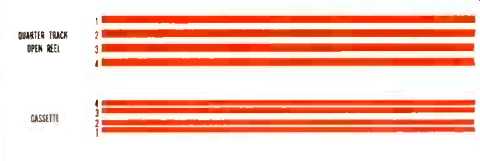
Fig. 1--Showing the difference between
quarter-inch, quarter-track open reel tape and 0.150 inch cassette tape.
Spacing is 0.03 inch between tracks on the open reel, with 0.037 inch track
width. Cassettes have 0.024 inch track width, with spaces of 0.011 inch between
tracks 1-2 and 3-4 and 0.032 down the center.
Measurements
First, a few words about the measurements and how they were carried out. After connecting up the machine, a head cleaning tape (Advocate or Realistic) is quickly run through and then a standard frequency (40 Hz to 10 kHz) is played. Then swept frequency recordings are made using standard FeO and CrO2 tapes--and LN low noise tape if appropriate. These frequency runs are made at a level of 20 dB below 0 VU. If the recorder is fitted with a Dolby or other noise suppression system, the measurements are repeated at 10 and 30 dB below 0 VU with the suppressor in circuit. These curves are not shown as the differences are not significant if the correct tape is used and the Dolby calibration is accurate. Next, recording level is increased to U VU and distortion measurements made using a 1 kHz signal and the Ferrograph RTS-1 Test Set. Levels are then increased to determine the 3% distortion point. Then signal-to-noise measurements are made by recording the 1 kHz signal at 3% level for a minute or two and comparing it with unrecorded tape. The signal is then erased and the efficiency noted. CrO2 was used for these tests where applicable. Next, wow and flutter were checked, again using the Ferrograph test set. This uses the new DIN standard of 3.15 kHz and the tape is passed through six times to get an average figure, thus avoiding sum and difference errors. The read-out figure is a combined one giving a weighted peak value in accordance with DIN standard 45507 approved by the IEEE. Wow and flutter varies slightly from one end of a cassette to the other so the same tape section was used for all measurements. Microphone and line input sensitivities were then measured-also the output voltages. Then the cassette rewind time is clocked. Finally, recordings were made from selected discs and the general handling of the machine evaluated. As a test for stability and reliability, the recorders were left running for 8 hours (not all at the same time) and then they were checked again. No significant changes were noticed--if anything, wow and flutter decreased slightly in some instances.
Two points ought to be stressed: one, it is essential that the tape heads be kept clean, and two, use the maker's recommended tape. Use a soft brush to remove oxides and occasionally pass a head cleaning tape thorough. Standard tapes vary considerably and if a LN tape is used on a machine adjusted for a standard tape, the response will tend to rise 3 to 4 dB in the 5 to 8 kHz region. CrO2 tapes are quite consistent and variations between the different makes was no more than a dB or so. These included Norelco 400, Sony CR-60, Advent Advocate, Memorex, and BASF Chromdioxide.
Some makers frown on the use of long playing C120 tapes but recently Advent announced that such tapes could now be used with their 201 without causing problems. The BASF anti jam cassette is a step in the right direction--so is the new TDK LN 180 series. This is a very thin (0.25 mils) low-noise tape which has a three hour playing time. It was used on all the machines for the reliability tests with no trouble whatsoever. Output is some 5 dB below normal-which might be a disadvantage under some circumstances.
-------
But Which One To Buy?
EVERAL OF THE DECKS tested came very close to each other in terms of basic performance so the choice will have to be based on features like a Memory switch which stops the tape at a pre-determined point so the start of a particular recording can be found without relying on the counter. Mixing facilities might be considered worthwhile--so is a limiter.
Some models do not have a stereo-mono switch; this might be considered important if you wish to record from a single source and play back through both loudspeakers. Especially if you do not have such a switch on your receiver or amplifier. Again, some models feature output level controls-a definite advantage if your amplifier does not have preset input controls. A DIN connecter is a must for some enthusiasts who have European equipment.
As to ease of operation, none of the machines tested were really bad but my ideal recorder-mechanically speaking-would have the Advent tape direction lever (perfect for inching) but with a lock, the pause control of the Pioneer, the eject button of the TEAC, Realistic or Lafayette, the Sansui VU meters, the stop control of the JVC and the input controls of the Concord. It would use the Panasonic auto-reverse and a Harman-Kardon servo motor, the Pioneer tape run indicator, the Sony ferrite heads-and it would be too expensive!
---------
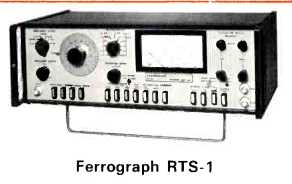
--------- Ferrograph RTS-1
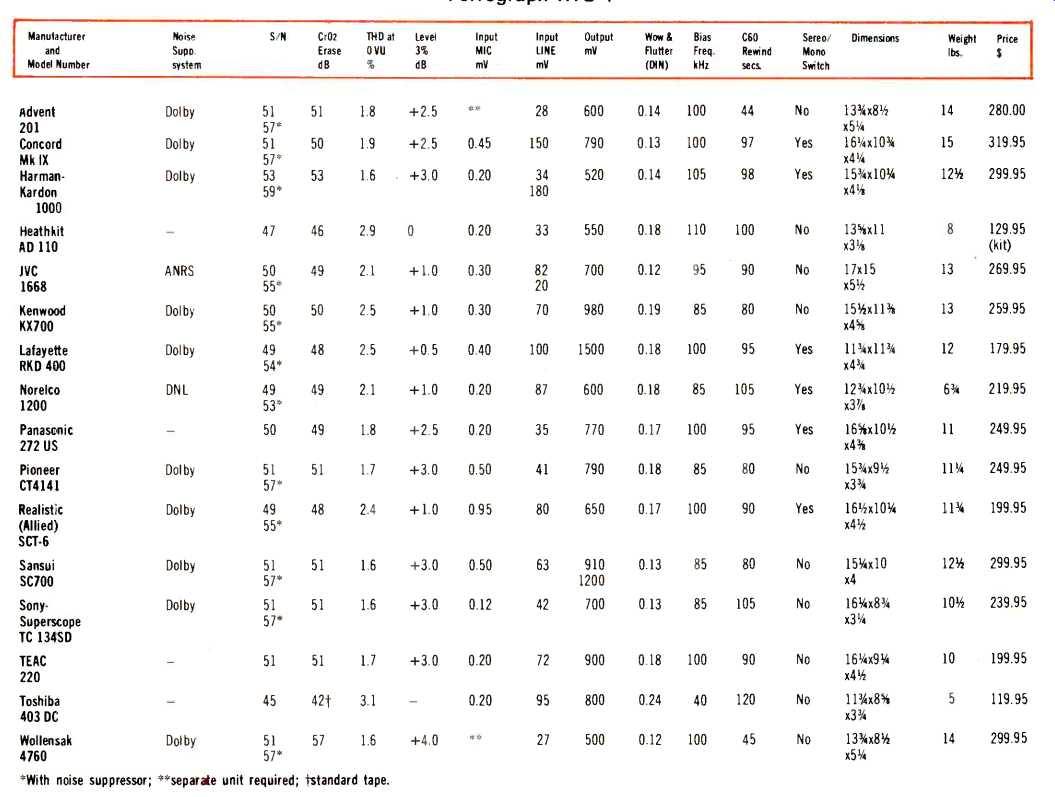
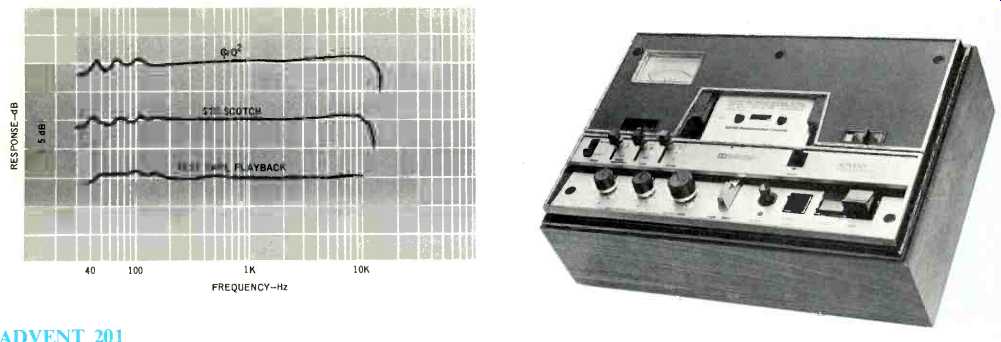
ADVENT 201
Controls: Three slide switches for stereo-mono, Dolby, and VU meter. Rocker switch for power on-off, record push-button, record level controls for each channel in addition to master control. On the right hand side are the record-play and stop piano keys and the pause button. In the center, at the front, is a horizontal lever for fast forward and rewind. On the left side is a recessed panel with input and output sockets, output level control, an 18-volt connection for optional microphone amplifier, and push-button to switch on the Dolby calibrating oscillator. A single VU meter (peak-reading) is used and the switch selects either channel or higher of both. The meter characteristics rise 12 dB from 100 Hz to 10 kHz to give a safer overload indication. Requires external microphone pre amp (Model MPR-1, $20) for recording from microphone.
This was one of the first cassette machines to make proper use of CrO2 tape and the necessary equalization is applied in both record and playback modes to get optimum results.
Frequency response within 2 dB from 40 Hz to 15 kHz with CrO2 and up to 13 kHz with standard tape. The slide tape direction lever was found exceptionally easy to use but no lock is provided so it has to be held in position. The pause control is a little awkward and stiff-some patience is needed to get used to it! A circuit diagram is on the bottom of the cabinet and the instruction manual is unusually detailed with all kinds of information therein. The 201 is well-made and it comes complete with head cleaning tape plus a test tape showing what can be achieved.

CONCORD MK–IX
Controls: Six keys for record, playback, rewind, fast-forward, pause and stop. Four push-buttons for Dolby, power on-off, stereo-mono, and CrO2-Std. tapes. Two slide controls for output, two for record level plus a separate mixing level control which enables another signal to be added to both channels.
These slide controls are mounted on the angled front panel and at the bottom are the microphone, mixing, and headphone jacks. Above the slide controls are the indicator lights for record mode and Dolby. At the rear are the input jacks-two high level and two low level plus the output sockets. The two 2 1/2-inch meters are mounted on a panel which is tilted up some 30 degrees.
The frequency response with CrO2 was within 2dB from 50 Hz to 14,500 Hz and up to 13 kHz with LN and 11 kHz with standard tapes. Motor is d.c., servo-controlled. The large VU meters are easy to read at a distance and the controls all worked smoothly with a nice professional feel. The instruction manual contained no technical information but the operating procedure is quite well presented.
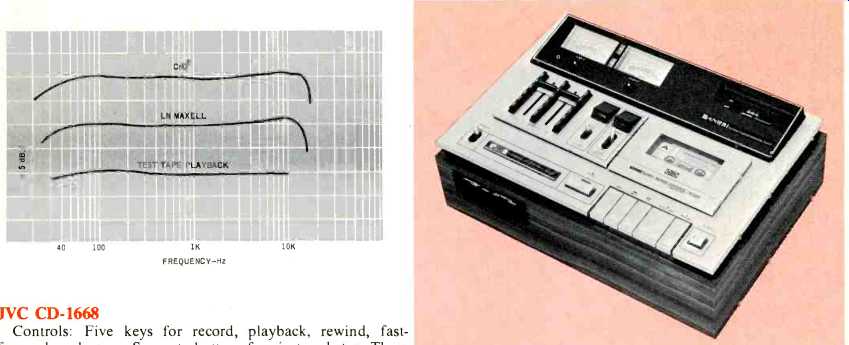
JVC CD-1668
Controls: Five keys for record, playback, rewind, fast forward, and pause. Separate buttons for eject and stop. Three position lever switch for CrO2, Std., and LN tapes. Lever switches for ANRS noise reduction and on/off. The two VU meters are mounted on an angled panel with the tape counter and Memory switch at the right. Between the meters is an indicator light which flashes at peak record levels. At the left are dual slide controls for record level and next to those, immediately behind the tape selector and ANRS switches, are illuminated indicators for those functions. At the front, in a recess, are the mic and headphone jacks-the latter input having a 2 position level control. At the rear are input and output sockets with a DIN connection.
Frequency response was within 2 dB from 40 Hz to 16 kHz with CrO2 and up to 14 kHz with LN tape. The ANRS noise reduction system operates by boosting low level input signals above 500Hz and then receiving the process for playback. It is reasonably compatible with Dolby "B" but not so elaborate or effective.
A nicely styled machine with some interesting features. Controls were easy to use and many enthusiasts will like the idea of separate stop and eject buttons which are placed to the left and right of the piano key set.
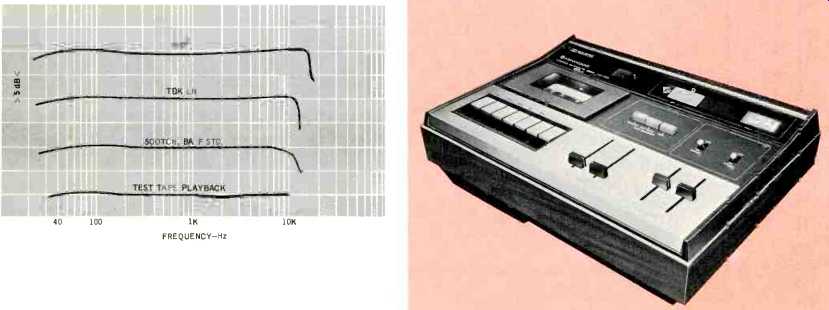
KENWOOD KX-700
Controls: Seven keys for record, playback, fast-forward, rewind, eject, stop, and pause. Three push-buttons for tape selection (CrO2, LN, Std.). Lever switches for Dolby and on-off; slide controls for record level and output. The two VU meters are angled and in between them are indicator lights for record mode and Dolby. At the front, right at the bottom, are the microphone and headphone jacks. At the rear are the input and output sockets plus a DIN connector.
The frequency response was within 2dB from 30 to 16,000 Hz with CrO2 and up to 13 kHz with LN tape. This is one of the few machines having provision for Standard. Low-Noise and CrO2 tapes. The instruction manual includes a schematic and has a good description of the Dolby system. A well-made deck, easy to handle. Styling is relatively clean and uncluttered.

HARMAN-KARDON 1000
Controls: Seven keys for record, playback, fast-forward, rewind, pause, eject, and stop. Lever switches for stereo-mono, CrO2-Std. tape, Dolby and Memory. Push-button on/off and test switch for Dolby calibration, slide controls for record level and playback. Also on the front panel are microphone input jacks with separate level controls and a headphone socket. At the rear are the output sockets with the high and low level input sockets. Other features include illuminated bars to indicate record and Dolby modes and special peak reading VU meters. A d.c. servo motor is fitted and a speed adjustment control is at the rear.
Frequency response was within 2 dB from 40 Hz to 16.5 kHz with CrO2 and up to 13 kHz with LN tape. Signal-to-noise was the best of those tested being 53 dB without Dolby and 59 dB with (unweighted). Controls were easy to use and the machine appears to be well-made. The plug-in circuit boards will certainly make life simpler for the service engineer!

HEATHKIT AD-110
Controls: Keys for record, playback, stop-eject, fast-forward, rewind, and pause. Separate rotary record level controls, power on-off switch. At the rear are the input sockets for high level signals, output sockets, and pre-set output controls.
This recorder comes as a kit but the transport section with piano key switches is already assembled. A large printed board is used for most of the electronics and total assembly time is about 5 hours. The built-in VU meters are used for setting the bias, circuit checking, and trouble-shooting.
Frequency response was within 2 dB from 40 Hz to 13 kHz using low-noise tape and up to 14 kHz with CrO2. Unfortunately, there is no tape selector switch. CrO2 bias changes are given in the manual' and it would not be that difficult to wire in a switch if both kinds of tape are going to be used. The two separate rotary input controls are a little difficult to use when controlling stereo signals. Apart from these criticisms, the AD 110 is an excellent general-purpose machine with a minumum of "frills." It should appeal to those who prefer to build their own or those on a limited budget.

LAFAYETTE RK-D40
Controls: Six keys for record, playback, fast-forward, rewind, stop, and pause. The eject button is mounted on top near the cassette recess. On the angled front panel are the two VU meters, two concentric controls for microphone, two more for line inputs, and a set of 3 push-buttons for CrO2-Std. tapes, Dolby, and stereo-mono. At the extreme right are the microphone jacks, and at the left are the on-off push-button and headphone jack. At the rear are the input and output sockets, a switched power outlet, and a 3-position headphone sensitivity switch.
Frequency response was within 2 dB from 50 Hz to 15 kHz with CrO2 and up to 10 kHz with standard tape. Both mic and line input sockets are connected at the same time to facilitate mixing. The instruction manual includes a schematic as well as a component location chart. At $179.95, this is the cheapest machine with a Dolby system and is good value for money.

NORELCO 2100
Controls: Keys for record, playback, fast-forward, rewind, pause and stop-eject. Three push-buttons for tape selection (CrO2, Std, and Low-Noise), push-buttons for stereo-mono, DNL noise reduction, on-off, and two slide controls for record level. At the front right, at the bottom, are the microphone and headphone sockets. Input and output sockets are at the rear. Above the slide controls are two lights, one indicating record mode and the other showing DNL operation. This noise reduction circuit functions on playback only and so is not comparable with Dolby-type systems. However, an improvement of 2 dB at 1 kHz and over 14 dB at 10 kHz was measured. Motor is servo-controlled.
Frequency response was within 2 dB from 50 Hz to 13 kHz with CrO2 and up to 12 kHz with LN tape and 10 kHz with standard tape. The DNL system sounded better than the figures indicate and of course it can be used with any recorded tape. Controls are positive but if the stop key is pressed too enthusiastically, the cassette will fly out-a little disconcerting! Styling is unprententious rather than streamlined-but functional.
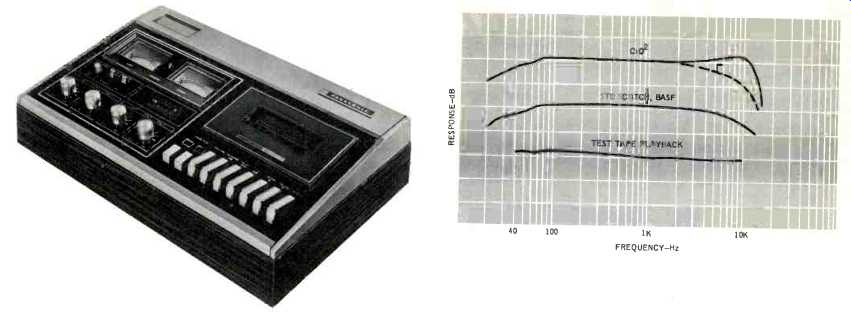
PANASONIC RS-272US
Controls: Seven keys for playback, record, fast-forward, rewind, eject, stop, and pause. Four rotary controls for input and output levels, lever switch for CrO2-Std., lever switch for noise reduction, and two push-buttons for tape direction.
Auto-reverse is incorporated but manual control is also provided. The tape reverses at the end of its traverse so after tracks 1 and 2 are played, 3 and 4 follow without turning the cassette over. There are two capstan assemblies-one at each end and the head is a 4-track type. This ingenious arrangement works on playback only.
Frequency response was within 2 dB between 40 Hz and 14,500 Hz with CrO2 and up to 10 kHz with standard tape. The dotted line shows the effect of the treble cut (NS) switch. No provision is made for Low-Noise tape-if such tape is used the response shows a rise of 3 to 4 dB in the 4 to 8 kHz band which is difficult to correct with tone controls. One small criticism-there is no lock on the pause control.
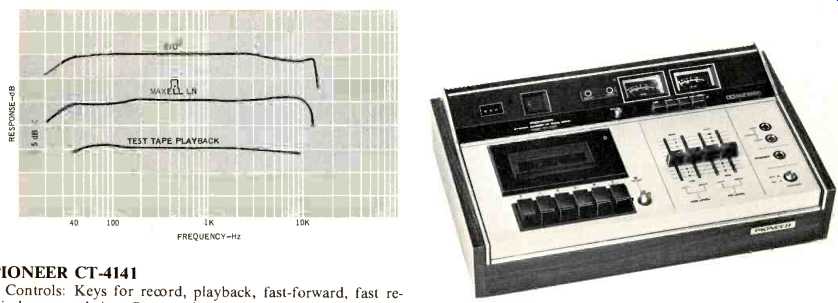
PIONEER CT-4141
Controls: Keys for record, playback, fast-forward, fast rewind, stop, and eject. Separate button for pause. Other switches for on/off, tape selector for CrO2, Std., Memory, skip button and Dolby. Four slide controls for input and output. On the left is a tape running indicator which uses a circular pattern. Illumination is white during playback, red during recording. Next to this device is a Dolby light and a peak level indicator which flashes at overload. The skip button just in front increases tape speed during playback while the tape is still in contact with the head. It is useful for finding a specific item on the tape and the output control can be turned down and headphones used for this purpose.
At the extreme right are the microphone and headphone jacks and the input-output sockets plus a DIN connector are at the rear. Motor is d.c. servo controlled.
Frequency response with CrO2 was within 2 dB from 40 Hz to 15 kHz and up to 14 kHz with LN tape. Controls are easy to use and this machine was one of the most versatile tested.
The mic and line inputs are not connected at the same time--which may be a disadvantage. A schematic is included with the instruction manual which is very comprehensive.
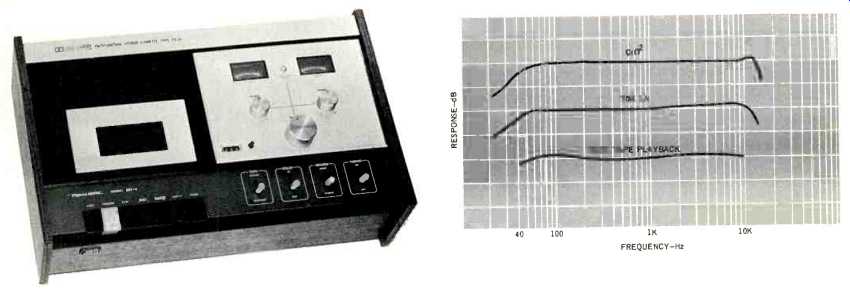
REALISTIC SCT-6
Controls: Seven keys for record, playback, fast-forward, rewind, eject, stop, and pause. Four lever switches for Dolby, CrO2-Std. tape, stereo-mono, power on-off. Above these are 3 rotary controls, one being the master record input control and the other two controlling the individual channels. Between the two VU meters is a record level indicator which flashes at overload point. At the rear are the input and out put sockets, microphone jacks, preset output control, and the Dolby calibration controls and test signal button.
Frequency response was within 2 dB from 40 Hz to 14 kHz with CrO2 and up to 12 kHz with LN tape. The input controls look a little clumsy compared with slide controls but they work very smoothly. The instruction book describes the Dolby system quite effectively and a schematic is included.
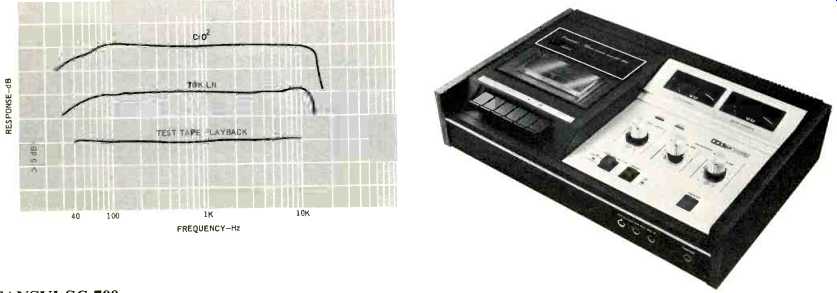
SANSUI SC 700
Controls: Six keys for record, playback, fast-forward, rewind, stop-eject, and pause. Three dual-concentric controls for center mic and line inputs and outputs. Push-buttons for CrO2-Std. tapes and Dolby. There are 3 microphone input sockets L, R, and Center and they are located at the front with the headphone jack. The two VU meters are mounted on an angled panel at the back and in front of them are the Dolby and record mode indicator lights. At the rear are the line output sockets (high and low levels), the input sockets, and a DIN socket. The motor is d.c. servo-controlled.
Frequency response with CrO2 was within 2 dB from 40 Hz to 15 kHz and within 2 dB from 40 Hz to 13 kHz with LN tape. The provision of a center channel mic input is an unusual feature and the output can be mixed with the line inputs if so desired. The VU meters are illuminated in green, white, and red and can be read at a considerable distance. A special felt-tipped pencil for head cleaning is supplied with the SC 700 and the instruction manual--which includes a schematic--is one of the best.

SONY TC-134 SD
Controls: Seven keys for record, playback, fast-forward, rewind, pause, stop, and eject. Three lever switches for Dolby, CrO2-Std. tape, and limiter. At the extreme right are the two slide record input controls and the on-off switch. At the right front are the microphone and headphone jacks. The record mode indicator light is just in front of the tape counter. At the rear are the input and output sockets.
Frequency response was within 2 dB from 32 Hz to 16 kHz with CrO2 and up to 13 kHz with LN tape. The limiter attenuates peaks above the +3 VU point and would be useful if the signal levels are not known. The piano keys are set back a little in a kind of recess and they have a positive but not too heavy feel. The automatic shut-off is designated TMS (Total Mechanism Shut-off) which is self-explanatory. This model is smaller in depth then most-which might be a plus if space is at a premium. No instruction manual was available (TC-134 SD is a new model) but it is assumed it will be complete and well-written in the Sony tradition.

TEAC 220
Controls: Six keys for record, playback, fast-forward, rewind, stop and pause. Separate button for eject, CrO2-Std. switch, on/off, two pairs of slide switches for record level and output. At the front, on the right, are the microphone and headphone jacks. The two large VU meters are mounted on an angled panel and between them is the record indicator light.
At the extreme left is a tape travel indicator which consists of a long amber lens on which a light shines through a slotted disc. At the rear are the input and output sockets with a DIN connector.
Frequency response was within 2 dB from 40 Hz to 15 kHz with CrO2 and within 2 dB from 40 Hz to 13 kHz with LN tape. This unit was one of the nicest machines to handle-the piano keys are indented and the separate eject button was less confusing than some. A version is available with a Dolby unit, this is Model 350 and it costs $289.50. Appearance is very similar to the 220 and it incorporates a peak recording level indicator and a line-mic switch. The peak indicating device uses light emitting diodes and is mounted between the VU meters.
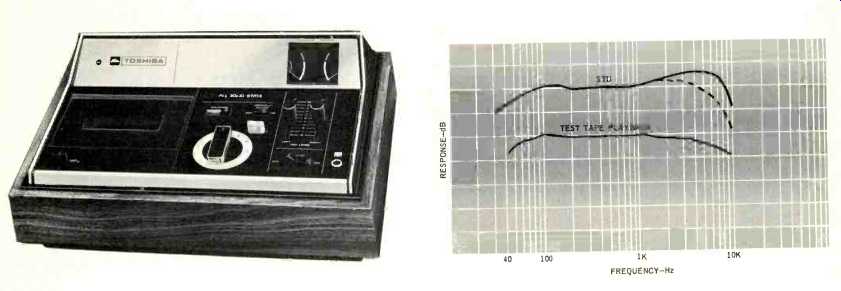
TOSHIBA KT 403D
Controls: Indented rotary switch for record-playback, stop, rewind, and fast-forward. Push button for record, two slide input controls, top cut slide switch, eject button, on-off switch. Tape end and record mode lights.
Frequency response was within 3 dB from 60 Hz to 10 kHz with standard tape. The dotted lines on the graph show the action of the tone control switch. This is a fairly inexpensive machine and we must admit we had some reservations about including it in this particular survey. However, wow and flutter-usually an unpleasant feature of such machines-is commendably low and frequency response is adequate for some "non hi-fi" requirements. No pause control is provided, and there is no automatic shut-off.
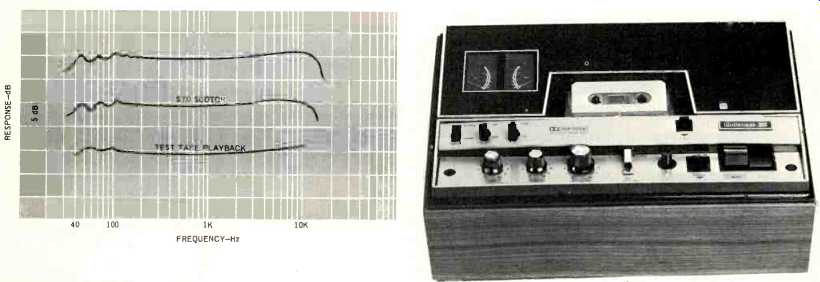
WOLLENSAK 4760
Controls: Stereo/mono rocker switch, Dolby and CrO2-Std. lever switches, slide switches for on/off, separate buttons for pause, record and eject, rotary controls for record level (one for each channel, plus master). In the center is a horizontal slide lever for fast-forward and rewind. On the left side is a recessed panel in which are mounted the input and output sockets, output level control, a Dolby calibrating push-button and an 18 volt connection for an optional microphone amplifier. This machine is very similar to the Avent 201, the major difference being the provision of two VU meters.
Frequency response was within 2 dB from 40 Hz to 15 kHz with CrO2 and within 2 dB from 40 Hz to 14 kHz with LN tape. Overall performance was comparable with the Advent and the same remarks regarding the pause control and tape direction control also apply. The cost is $20.00 more and whether the convenience of having two meters justifies this will be a matter of personal choice. Instruction manual is comprehensive and a schematic is on the underside of the recorder.
(Adapted from: Audio magazine, Oct. 1972)
Also see:
Audio Tests Nine Phono Cartridges (Aug. 1973)
= = = =